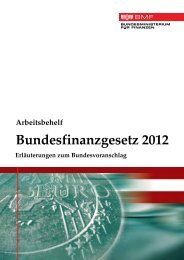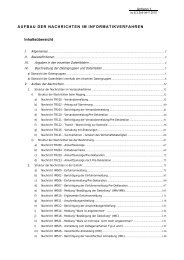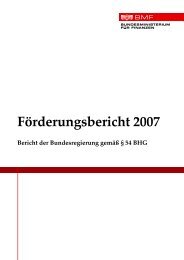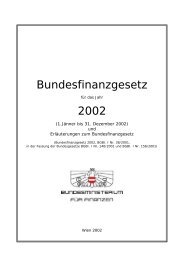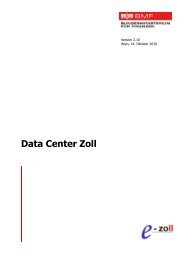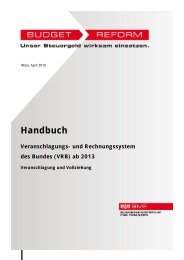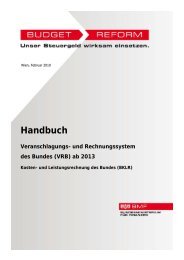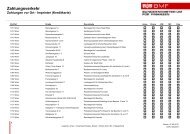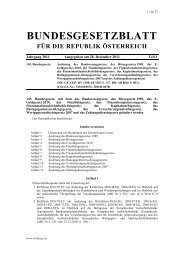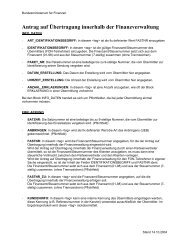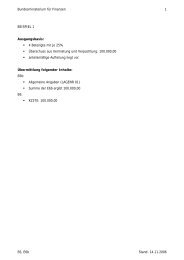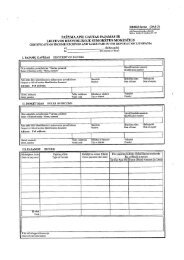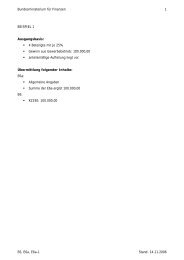Fallback and Recovery Specification (FRS)
Fallback and Recovery Specification (FRS)
Fallback and Recovery Specification (FRS)
Create successful ePaper yourself
Turn your PDF publications into a flip-book with our unique Google optimized e-Paper software.
DG TAXUD – EXCISE COMPUTERISATION PROJECT REF: ECP2-FITSDEV2-SC03-<strong>FRS</strong><br />
FALLBACK AND RECOVERY SPECIFICATION (<strong>FRS</strong>) VERSION: 3.11-EN<br />
Specific provisions during the rollout of EMCS<br />
8 Specific provisions during the rollout of EMCS<br />
This chapter describes the specific provisions to be applied to the fallback <strong>and</strong> recovery<br />
procedures of EMCS during Migration Period 1 defined in the PSS [R3] namely:<br />
FS0/FS1 coexistence during Migration Period 1 (rollout of the FS1 functionality).<br />
This analysis is essentially based on the General Process Threads <strong>and</strong> Support Threads<br />
described in the Appendix A of the Phasing <strong>and</strong> Scope <strong>Specification</strong> (PSS).<br />
The exceptions <strong>and</strong> the related scenarios are described in the Appendix A of the PSS<br />
where they are explicitly addressed. These exceptions or scenarios are either specific to<br />
the migration periods or extended from the unavailability exceptions of the target system.<br />
It shall be noted that no specific provisions apply to the fallback <strong>and</strong> recovery procedures<br />
of EMCS during the operations of Phase 3, since according to the updated Master Plan<br />
[R7] there will be no co-existence of FS1 <strong>and</strong> FS2 (all MSAs will enter the EMCS Phase<br />
3 operations at milestone Mc).<br />
8.1 <strong>Fallback</strong> <strong>and</strong> recovery during Migration Period 1<br />
Most generally, the design of FS0/FS1 is intended to provide a full service to all<br />
movements that can be electronically submitted in a Member State in FS1, FS0 being<br />
exactly tailored to ensure the destination functionality.<br />
Therefore:<br />
� the fallback <strong>and</strong> recovery provisions that are defined in the <strong>FRS</strong> concerning the use<br />
cases included in FS1 are adequate to respond to the exceptions arising during the<br />
coexistence of FS0 <strong>and</strong> FS1; note in particular that the management of SEED <strong>and</strong> of<br />
reference data being a prerequisite to the migration milestone Ma, the related use cases<br />
are to be considered a part of FS0;<br />
� all complementary requirements attached to these exceptions must be considered an<br />
integral part of FS0 or of FS1, according to the EBP where the exception arises.<br />
In addition, a few particular cases deserve setting up temporary responses.<br />
8.1.1 Unavailability of the automatic triggering of risk assessment<br />
The automatic connection with the risk assessment functionality is not included in FS1;<br />
until the concerned MSA is in FS2, it is replaced by a manually triggered fallback risk<br />
assessment that may result in fallback administrative cooperation exchanges.<br />
This is not really an exception; however it has been explicitly mentioned in the Appendix<br />
A for all application points of risk assessment in all use cases of the FESS [R6] that<br />
belong to FS1.<br />
8.1.2 Exportation of goods in an MSA different from the MSA of dispatch<br />
The exportation functionality is supported through three use cases, all of which are<br />
assigned to FS1 (no EBP has been included in FS0).<br />
ECP2-FITSDEV2-SC03-<strong>FRS</strong>v3.11.doc Page 51 of 53



